how long is a day on jupiter
Key Facts & Summary
- Since it is the fourth brightest object in the sky, Jupiter was observed since aboriginal times and thus no 1 tin exist credited for its discovery. All the same, the first telescopic observations were conducted past Galileo Galilei in 1609 and in 1610 Galileo also discovered the major moons of Jupiter, but of class non the smaller ones.
- Since many cultures observed Jupiter, they all gave it different names but the Roman name remained used in the majority of cultures. Jupiter is named afterward the principal Roman god, the equivalent of the Greek god Zeus.
- Jupiter is 1 of the five visible planets (Mercury, Venus, Mars, Saturn), beingness the fifth about distant from the Dominicus at an boilerplate distance of 5.2 AU, its closest approach is at 4.9 AU and at its farthest 5.4 AU. Its verbal position can exist checked online since the planet is constantly tracked.
- Information technology is the biggest planet of the Solar Organization, with a hateful radius of 43.440 miles / 69.911 km, a diameter at the equator of almost 88.846 mi / 142.984 km, and at the poles, the bore is only 83.082 mi / 133.708 km.
- Jupiter is also twice as massive every bit all the other planets combined, having 318 times the mass of World.
- The gas giant has a gravity of 24.79 thou/s², a little more than twice of Earth. Its powerful gravity has been used to hurl spacecraft into the farthest regions of the solar system.
- Jupiter rotates once every 10 hours – A Jovian twenty-four hour period - thus it has the shortest day of all the planets in the solar system.
- A Jovian year is about 12 Globe years, quite long in comparison to its brusk days.
- Since Jupiter has a small centric tilt of only iii.thirteen degrees, information technology has fiddling seasonal variations.
- Jupiter does not accept a solid surface being comprised mostly out of swirling gases and liquids such as ninety% hydrogen, ten% helium – very like to the sun.
- A very small fraction of the atmosphere is made up of compounds such as ammonia, sulfur, methyl hydride, and water vapor. Jupiter'south atmosphere is the largest planetary atmosphere in the solar system. Information technology makes up almost the unabridged planet.
- Information technology holds a unique identify in the history of space exploration since after it was observed through the telescope, some of its moons were also discovered and because of this, their movements were observed thus ending the conventionalities that everything orbited the Earth.
- Though it remains the biggest planet, Jupiter has been dethroned as the moon king by Saturn, which at present has 82 moons. Jupiter currently has only 79 known satellites.
- Amidst these satellites, four of them are quite famous: Io – for its volcanic activity, Ganymede – for its size, being the largest known moon of any planet, Europa – for hosting favorable weather to notice present-day environments suitable for some grade of life beyond World, and Callisto – that may also host a subsurface ocean. They are known every bit the Galilean moons.
- Jupiter has 3 ring systems though they are fainter and smaller than Saturn's. They are mostly made up of dust and small rocky pieces.
- It has a very stiff magnetosphere, almost 20 times stronger than Globe's magnetic field and 20.000 times larger.
- Equally a outcome, the aurora of Jupiter is stronger likewise. Information technology produces almost a meg Megawatts – Earth's aurora produces virtually 1.000 Megawatts.
- A distinct characteristic of Jupiter is its Great Red Spot – a persistent high-force per unit area region in the atmosphere that produces an anticyclonic storm, the largest in the solar organisation. Information technology has been observed since 1830, and it is active for hundreds of years. Information technology is too shrinking.
- Jupiter is surrounded past a plasma torus, produced by its stiff magnetic field. It is a field of extremely charged particles making it hard for a spacecraft to approach the planet, yet some zones are a bit safer. The charged particles also come from Io's volcanic activity.
- The combination of the powerful magnetic field and the charged particles in the plasma torus creates the brightest auroras in the solar system. Sadly, they can only be seen through ultraviolet.
- It is now known if Jupiter has a core and contempo analysis suggests that the temper extends upwardly to iii.000 km / 1.864 mi down, and beneath this is an bounding main of metal hydrogen going all the way down to the center. About eighty-90% of its radius is now believed to be a liquid or technically, an electrically conducting plasma, perhaps like to liquid mercury.
Jupiter is the fourth brightest object in the sky, visible to the naked middle. Information technology shines so brightly that even Venus dims in comparing. Because of this, it has been observed since aboriginal times by many different cultures. The discovery of Jupiter cannot exist attributed to someone.
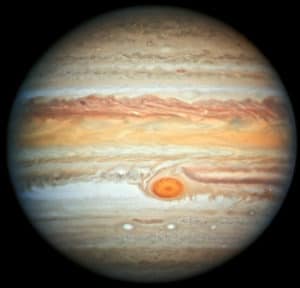
Notwithstanding, Galileo Galilei is the outset astronomer to take observed Jupiter through his telescope. He began extensive observations of the planet in 1609. During this time and until 1610, Galileo discovered the iv largest moons that orbit Jupiter: Io, Europa, Ganymede, and Callisto. They are chosen the Galilean moons in his honor.
He first thought of them every bit "fixed stars" only over time he witnessed that the objects changed positions, and he even nearly correctly deduced their periods. This discovery was revolutionary since, at the time, almost of Europe still endorsed the theory that all the planets orbited Globe.
Galileo's discovery paved the way for the heliocentric model of the solar system, in which the planets orbit the Sun. Jupiter was known to the Babylonians as Marduk, the patron deity of the city of Babylon. The Romans chosen it "the star of Jupiter" - equally they believed information technology to be sacred to the principal god of Roman mythology, whose name comes from the Proto-Indo-European vocative compound *Dyēu-pəter.

Jupiter is the counterpart to the mythical Greek king of the gods, Zeus, this proper noun is retained even at present in the modernistic Greek language. The ancient Greeks used to call Jupiter, Phaethon, which means "blazing star." As supreme god of the Roman pantheon, Jupiter was the god of thunder, lightning, and storms, and appropriately chosen the god of light and sky.
Germination
Throughout the universe, there are many planetary systems similar to ours. Most of them comprise terrestrial planets like our own and gas giants like Jupiter. However, they also contain super-Earths – planets that are several times more massive than Earth.
This indicates that our ain Solar System should besides take these types of planets and it is hypothesized that we did have them but they collided with Jupiter in the early formation of the Solar System. This resulted in Jupiter'southward migration from the inner solar system to the outer solar arrangement and thus allowed the inner solar planets to class. This theory is called the K Tack Hypothesis.
At that place are theories that hypothesize the fact that Jupiter may have formed before the Dominicus while others state that Jupiter formed later the sun about 4.5 billion years ago. Gravity pulled swirling gas and dust and resulted in the creation of Jupiter. Quondam around 4 billion years ago Jupiter settled in its current position in the outer solar system.
Altitude, Size and Mass
It is the fifth most distant from the Sunday with an average distance of about five.2 AU. The closest arroyo is at four.9 AU and at its farthest v.4 AU. Its exact position tin can be checked online since the planet is constantly tracked.
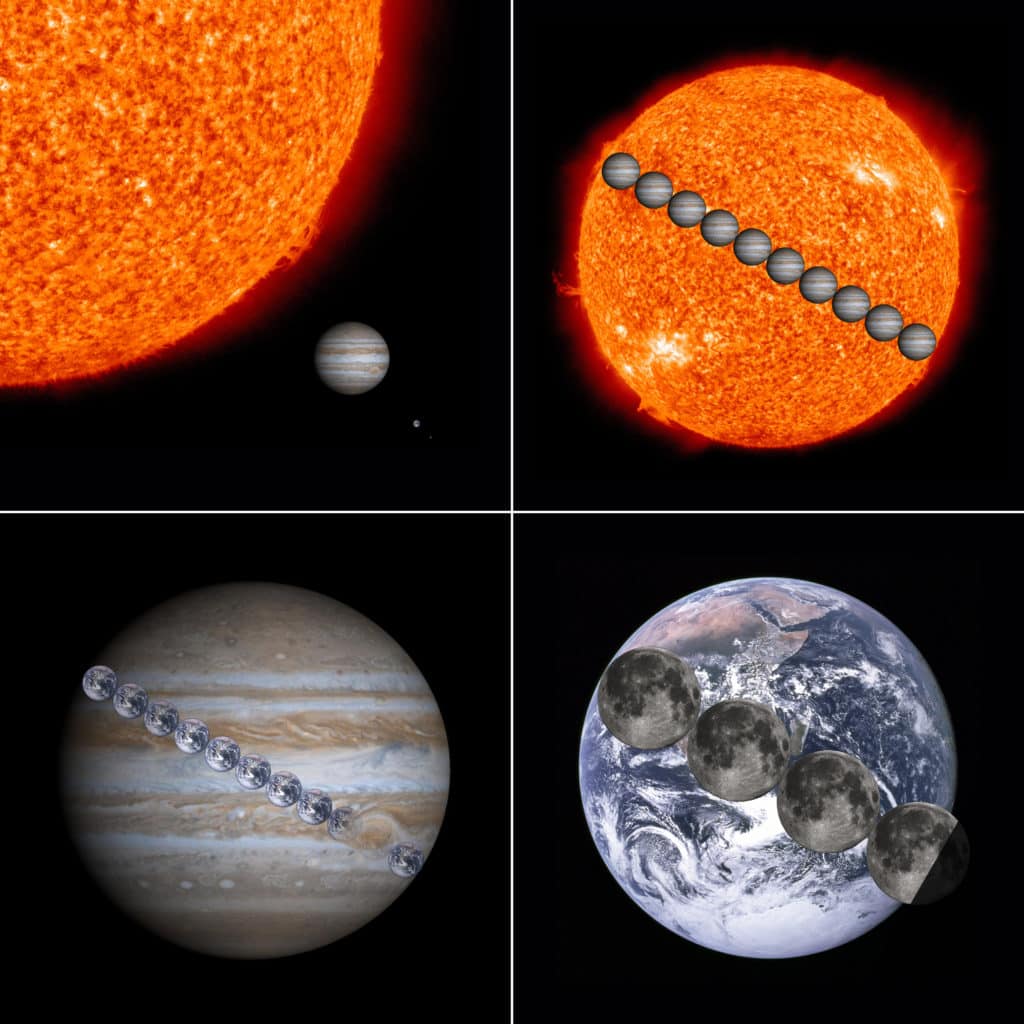
Information technology is the biggest planet of the Solar System, with a mean radius of 43.440 miles / 69.911 km. Almost xi times bigger than Earth. Jupiter'south radius is virtually ane/10 the radius of the Lord's day, and its mass is 0.001 times the mass of the Sun, then the densities of the two bodies are similar.
The diameter at the equator of about 88.846 mi / 142.984 km, and at the poles, the bore is just 83.082 mi / 133.708 km. The boilerplate density of Jupiter is nearly 1.326 g/cm3, much smaller than all the terrestrial planets.
Jupiter is also 2.5 times more massive than all the other planets combined, having 318 times the mass of Earth. It has a volume of near 1,321 Earths.
Orbit and Rotation
Jupiter rotates once every ten hours – A Jovian day - thus it has the shortest day of all the planets in the solar organization. A Jovian year, on the other hand, is about 12 Earth years, quite long in comparison to its brusk days. The orbital menstruation is virtually two-fifths that of Saturn. The orbit of Jupiter is elliptical, inclined near 1.31 degrees when compared to World.
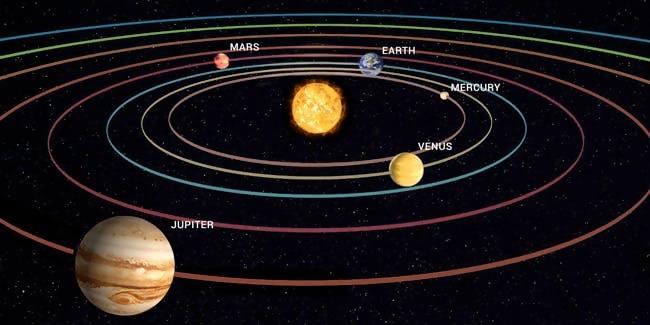
The eccentricity of the orbit is about 0.048. This results in its distance from the Sun varying from its perihelion to aphelion by about 75 1000000 km / 46 mi. Jupiter's upper temper undergoes differential rotation since it's made out of gases.
Axial tilt
Since Jupiter has a small-scale axial tilt of only 3.13 degrees, it has footling seasonal variations Considering of this depression tilt the poles constantly receive less solar radiation than at the planet's equatorial region.
Structure
Jupiter does not take a solid surface being comprised mostly out of swirling gases and liquids such as 90% hydrogen, ten% helium – very like to the lord's day.
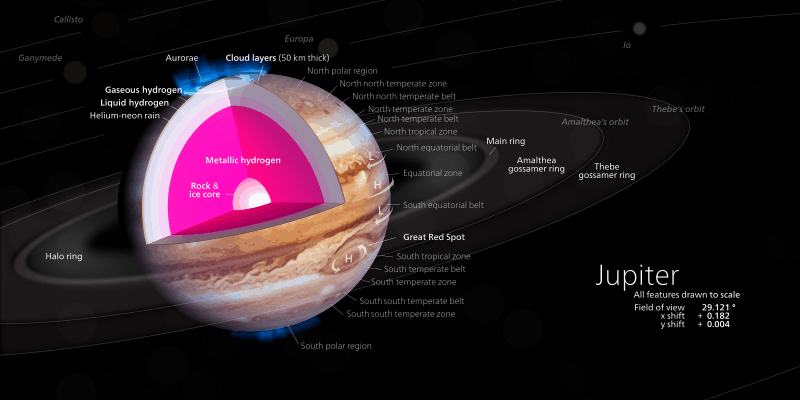
It is now known if Jupiter has a core and recent analysis suggests that the temper extends up to 3.000 km / i.864 mi down, and beneath this is an sea of metal hydrogen going all the manner downwards to the center. About fourscore-90% of its radius is now believed to exist liquid or technically - electrically conducting plasma – it may exist similar to liquid mercury. The Juno mission will reveal more about Jupiter's inner structure and if indeed it has a core.
Atmosphere
The atmosphere of Jupiter is the largest planetary atmosphere in the Solar Organisation, spanning over five.000 km / 3.000 mi in altitude. It is perpetually covered with clouds composed of ammonia crystals and possibly ammonium hydrosulfide.
The clouds are located in the tropopause and are arranged into bands of unlike latitudes, known as tropical regions sub-divided into lighter-hued zones and darker belts. Because of their interactions, having conflicting circulation patterns, storms and turbulences are created.
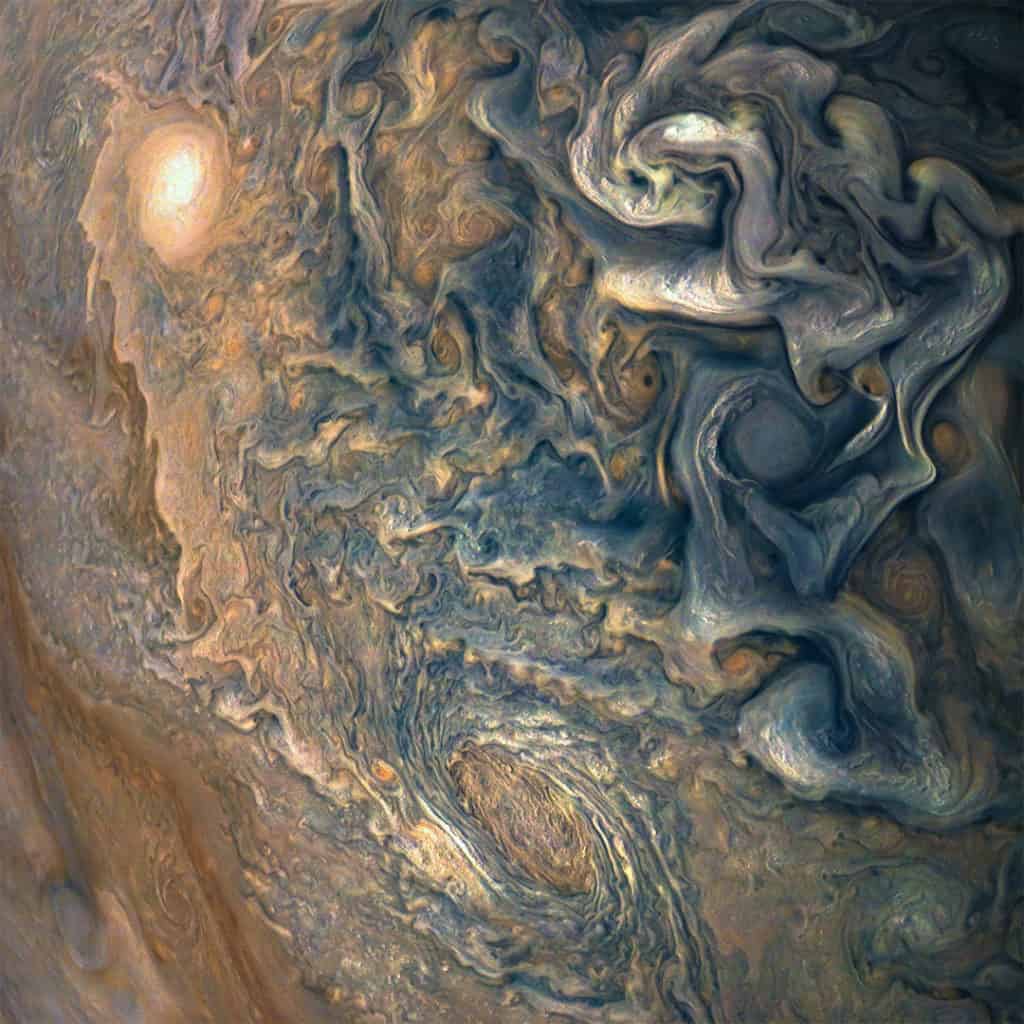
Air current speeds of 100 m/southward – 360 km/h are common in the zonal jets. The deject layer is only about fifty km / 31 mi deep, consisting of at least two decks of clouds – a thin clearer region and a lower thick one.
The upper temper is calculated to exist comprised of near 88-92% hydrogen and 8-12% helium. Since helium atoms accept more mass than hydrogen atoms, the limerick changes. The atmosphere is thus estimated to be approximately 75% hydrogen and 24% helium with the remaining 1% of the mass consisting of other elements such as methane, water vapor, ammonia, silicon-based compounds, carbon, ethane, oxygen and more than.
The outermost layer of the temper contains crystals of frozen ammonia. The interior denser materials by mass are roughly 71% hydrogen, 24% helium and v% other elements. These atmospheric proportions of hydrogen and helium are close to the theoretical composition of the primordial solar nebula.
Magnetosphere
The magnetic field of Jupiter is fourteen times stronger than that of World. It ranges from 4.2 gauss / 0.42 mT at the equator to 10-14 gauss / 1.0 – i.four mT at the poles.
This makes Jupiter's magnetic field the strongest in the Solar Arrangement, with the exception of some phenomenon named "sunspots", that occur on the Dominicus that are even stronger.
Information technology is believed that the liquid metallic hydrogen nowadays in Jupiter is responsible for this forth with the volcanic activity present on Jupiter's moon Io that emits large amounts of sulfur dioxide forming a gas torus along the moon's orbit. This gas is ionized in the magnetosphere and through different influences creates a plasma sheet in Jupiter'due south equatorial airplane. This causes the deformation of the dipole magnetic field into that of a magnetodisk.
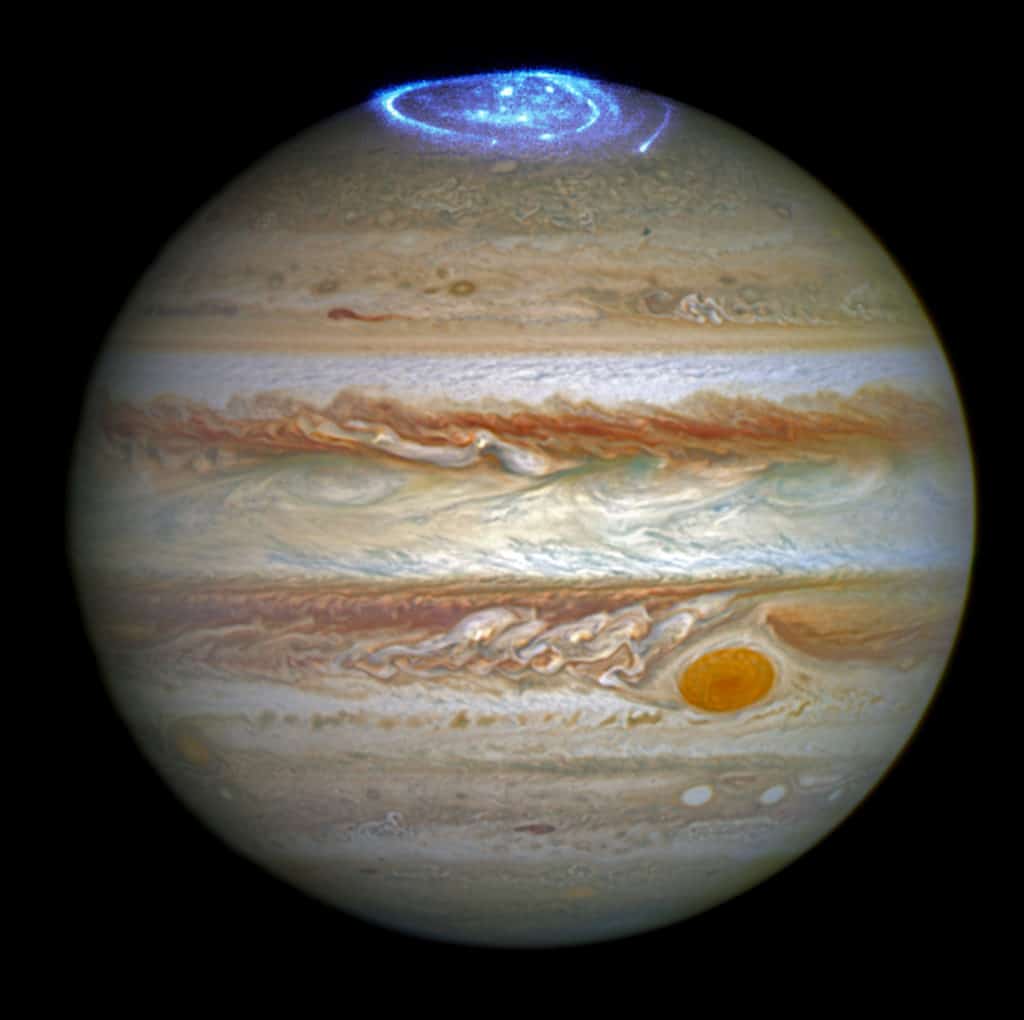
Equally a result, the aurora of Jupiter is stronger likewise. Information technology produces almost a meg Megawatts – Earth's aurora, in comparison, produces virtually ane.000 Megawatts. The combination of the powerful magnetic field and the charged particles from Io in the plasma torus creates the brightest auroras in the solar arrangement. Sadly, most of them can only be seen through ultraviolet.
Because Jupiter is surrounded past this plasma torus, produced by its strong magnetic field, information technology makes it very difficult for a spacecraft to approach the planet, nonetheless some zones are not so dangerous but the radiation is notwithstanding nowadays.
Climate
Data suggests that the temperature on Jupiter varies from -145 degrees Celsius / -234 degrees Fahrenheit in the clouds too much higher temperatures virtually the planet'southward center. Some estimates concluded that it would get even hotter than the surface of the Sun.
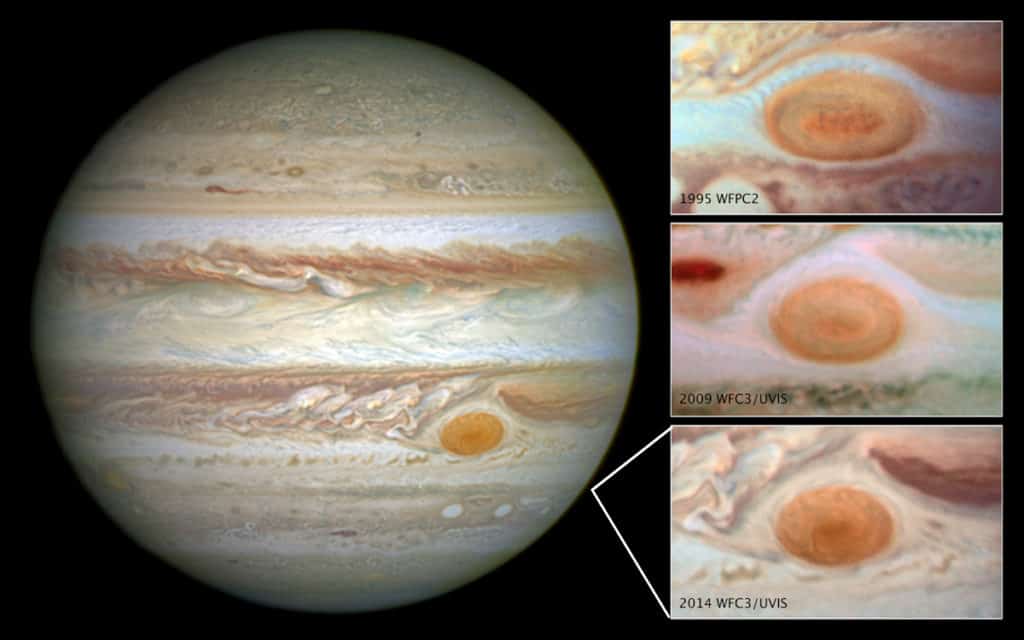
One of the key features of Jupiter is its Bang-up Ruby-red Spot. A storm that's existed since 1831, and peradventure since 1665. This oval-shaped object is greater in size than Earth and rotates counterclockwise within a period of six days. Its maximum altitude is near 8 km / 5 mi above the surrounding cloud tops. Since its discovery, it has decreased in size and recent observations state that it decreases in length past about 930 km / 580 mi per year. Storms are common on Jupiter, some are small-scale and last hours while others are huge and last for centuries. Air current speeds of 100 m/s – 360 km/h are common on certain parts of the planet.
Moons
Jupiter was the male monarch of the moons since recently, having a full of 79 known satellites. Recently, Saturn dethroned Jupiter having a total of 82 known satellites. These rankings can change as observations continue.
Out of the 79 satellites, 63 are less than 10 km / 6.2 mi in diameter, and have merely been observed since 1975. The Galilean moons, Io, Europa, Ganymede, and Callisto are large enough to exist seen from Globe with binoculars. They are among the largest satellites discovered in the Solar Organisation with Ganymede being the largest out of all the satellites in our solar organisation.
Jupiter has both regular moons and irregular moons with further sub-divisions.
Regular moons
The regular moons of Jupiter consists of the Galilean moons and an inner group of 4 small moons with diameters less than 200 km / 124 mi, and orbits with radii less than 200.000 km / 124.274 mi. They all have orbital inclinations of less than half a degree. The Galilean moons orbit between 400.000 and 2.000.000 km – 248.548 mi and 1.242.742 mi. These moons are believed to take been formed together with Jupiter since they accept nearly circular orbits near the plane of Jupiter'south equator.
Ganymede
Despite existence the largest known satellite in the solar system, it lacks a substantial atmosphere. It is the 9thursday largest object in the solar organization with a diameter of 5.268 km / 3.273 mi and is 8% larger than the planet Mercury, although only 45% as massive.

Information technology was named after the mythological cupbearer of the Greek gods, who was kidnapped past Zeus for this purpose. Information technology is the only moon known to have a magnetic field and though it posseses a metal core, it has the lowest moment of inertia factor of whatever solid body in the Solar Organization.
Outward from Jupiter, it is the 7th satellite completing an orbit around Jupiter in nearly 7 Earth days. Information technology is in a 1:2:4 orbital resonance with the moons Europa and Io. Information technology is comprised more often than not of equal amounts of silicate rock and water water ice, having an fe-rich, liquid core, and an internal ocean that may contain more water than all of Earth'due south oceans combined.
A third of its surface is covered by dark regions covered in bear on craters and a light region, crosscut by extensive grooves and ridges possibly due to tectonic activity due to tidal heating. It has a thin atmosphere comprised of oxygen, ozone and other elements. There is some speculation on the potential habitability of Ganymede's ocean.
Io
The innermost and tertiary-largest of the four Galilean moons of Jupiter, Io is the fourth-largest moon the solar system with the highest density and the to the lowest degree amount of water molecules of whatever known astronomical object in the Solar Arrangement.
Named afterwards the mythological character Io, a priestess of Hera who became one of Zeus' lovers, Io is the almost geological active object in the Solar organisation having over 400 active volcanoes.
This extreme geological activity is due to tidal heating caused from friction generated within Io's interior equally information technology is pulled between Jupiter and the other Galilean moons.
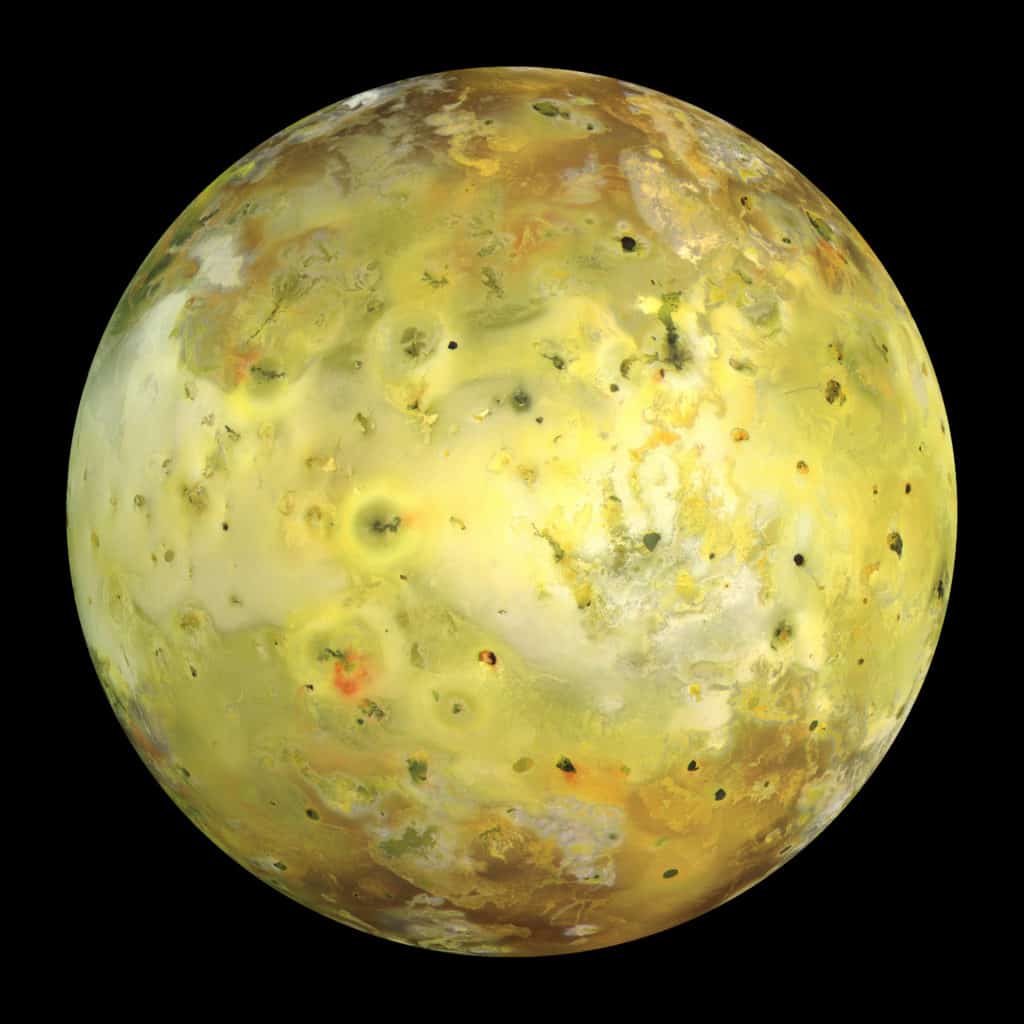
Information technology takes Io ane.77 Globe-days to orbit Jupiter. It is tidally locked to Jupiter, showing only one side to its parent planet, and has a mean radius of one.131 miles / 1.821 km, slightly larger than Earth's moon.
Many of Io'south volcanoes produce plumes of 500 km / 300 mi to a higher place the surface. More 100 mountains are uplifted by extensive compression at the base of Io'southward silicate chaff. Some of these peaks are taller than Mount Everest, the highest point on Earth's surface.
Io is equanimous primarily of silicate rock that surrounds a molten iron core. The plains of Io are coated with sulfur and sulfur-dioxide frost. The materials produced by Io's volcanism make up its thin atmosphere, and result in the large plasma torus effectually Jupiter.
Europa
Europa is the smallest of the iv Galilean moons and the sixth largest of all the moons in the Solar Arrangement. It was named afterward the Phoenician mother of King Minos of Crete and lover of Zeus.
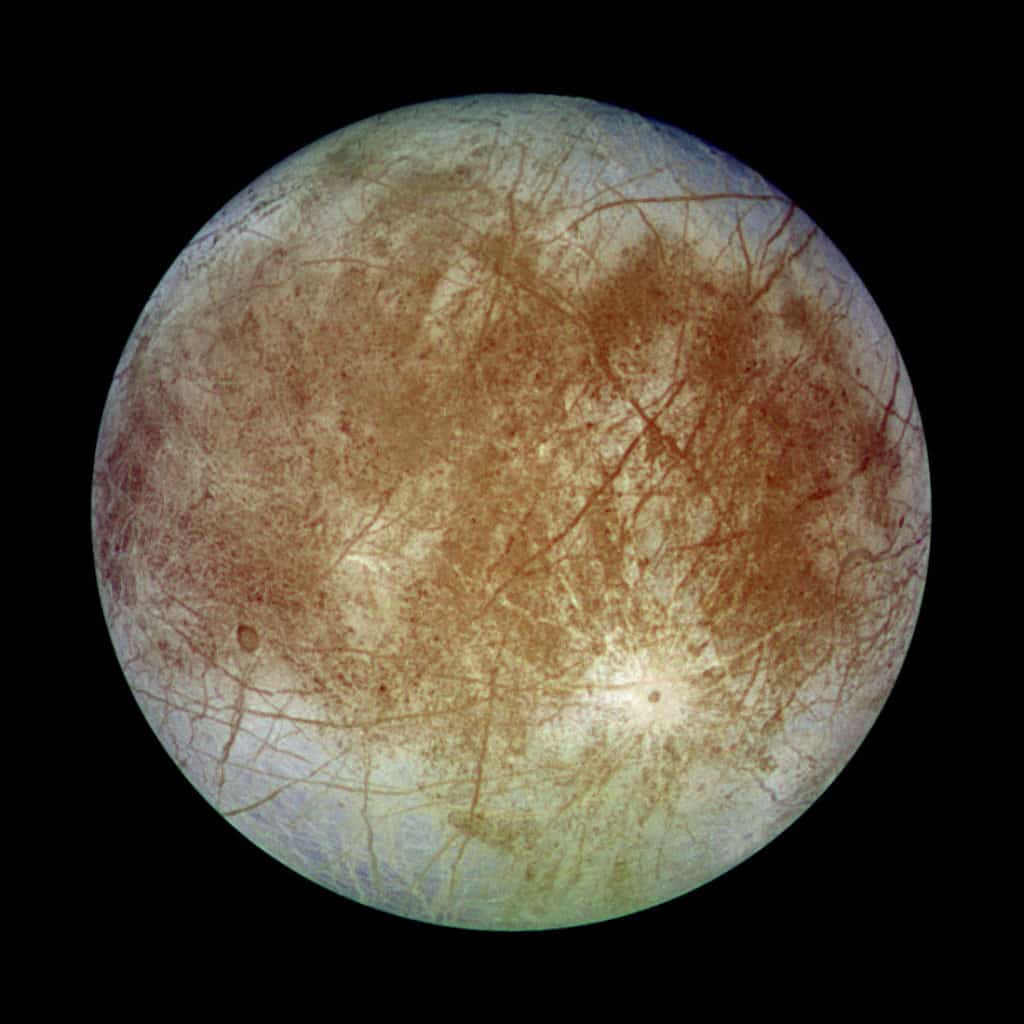
It is slightly smaller than Earth's moon having a diameter of 3.100 km / one.900 mi. It is primarily fabricated of silicate rock and has a h2o-ice chaff, and a probably fe-nickel cadre.
Its atmosphere is thin, composed primarily of oxygen. The surface is very polish. In fact information technology is the smoothest of any known solid object in the Solar Organization. The credible youth of the smoothness of the surface led to the hypothesis that a water bounding main exists beneath it, which could conceivably harbor extraterrestrial life.
Currently, Europa probably has the highest of either having or developing life, and thus it is one of the most closely studied objects in the solar arrangement.
Callisto
Callisto is the second-largest moon of Jupiter and the third-largest moon in the Solar System afterwards Ganymede and Saturn'south moon Titan. Information technology has a bore of nearly 4.821 km / 2.995 mi, having about 99% the diameter of the planet Mercury but simply a third of its mass.
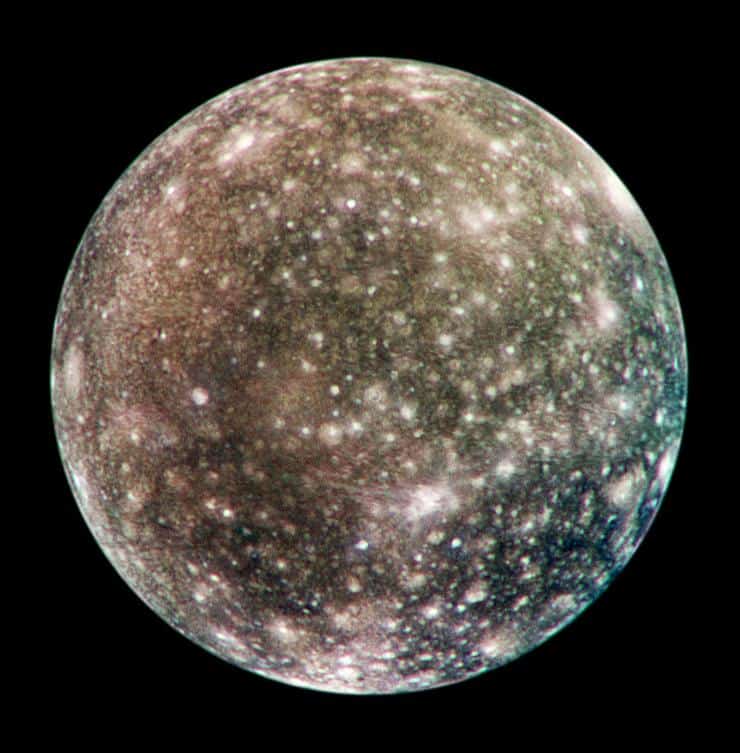
Named after a nymph of Greek mythology, also another ane of Zeus's lovers, Callisto is the farthest Galilean moon orbiting Saturn at a distance of ane.viii million km. Information technology is not in a orbital resonance like the other three Galilean moons and thus it is not appreciably tidally heated like the others. It is tidally locked with Jupiter and it is less affected by Jupiter's magnetosphere than the other inner satellites considering of its remote orbit.
It is composed primarily out of equal amounts of rock and ices, with a density of about 1.83 g/cm3, the lowest of Jupiter'due south satellites. Investigations past the Galileo spacecraft advise that Callisto has a silicate core and mayhap a subsurface ocean of liquid h2o at depths of 100 km.
Interestingly, the surface of Callisto is the oldest and most heavily cratered in the Solar System. Information technology has an extremely thin atmosphere composed of carbon dioxide and probably molecular oxygen.
The presence of an ocean within Callisto opens the possibility that it could harbor life simply conditions are idea to be less favorable than on Europa. Regardless, information technology is considered the most suitable planet for a human base for future exploration of the Jovian system due to low radiation levels.
Irregular Moons
The irregular moons are minor and have elliptical and inclined orbits. They are idea to exist captured asteroids or fragments of captured asteroids. Their exact number is unknown but they are farther divided into sub-divisions – groups, in which they share similar orbital elements and thus may have a common origin.
There are 4 groups:
- The Himalia grouping – a clustered group of moons with orbits around xi million to 12 million km / half dozen to seven one thousand thousand mi from Jupiter.
- The Ananke group – a grouping with a retrograde orbit with rather indistinct borders, averaging from 21 meg km / thirteen million mi from Jupiter with an boilerplate inclination of 149 degrees.
- The Carme group – they are a group with a fairly distinct retrograde orbit that averages from 23 meg km / 14 million mi from Jupiter with an average inclination of 165 degrees.
- The Pasiphae group – a very dispersed and but vaguely distinct retrograde group that covers all the outermost moons.
- There are iii irregular moons that stand out from these groups:
- Themisto – it orbits halfway between the Galilean moons and the Himalia group.
- Carpo – it is at the inner edge of the Ananke grouping and orbits Jupiter in prograde direction.
- Valetudo – this moon has a prograde orbit merely overlaps the retrograde groups and may event in future collisions with those groups.
Planetary Rings
Jupiter has a faint planetary ring system composed of three main segments: an inner torus of particles known every bit the halo, a relatively bright main ring, and an outer gossamer band.
They appear to exist fabricated out of dust rather than water ice as with Saturn'south rings. It is believed that the main ring is made of cloth ejected from the satellites Adrastea and Metis.
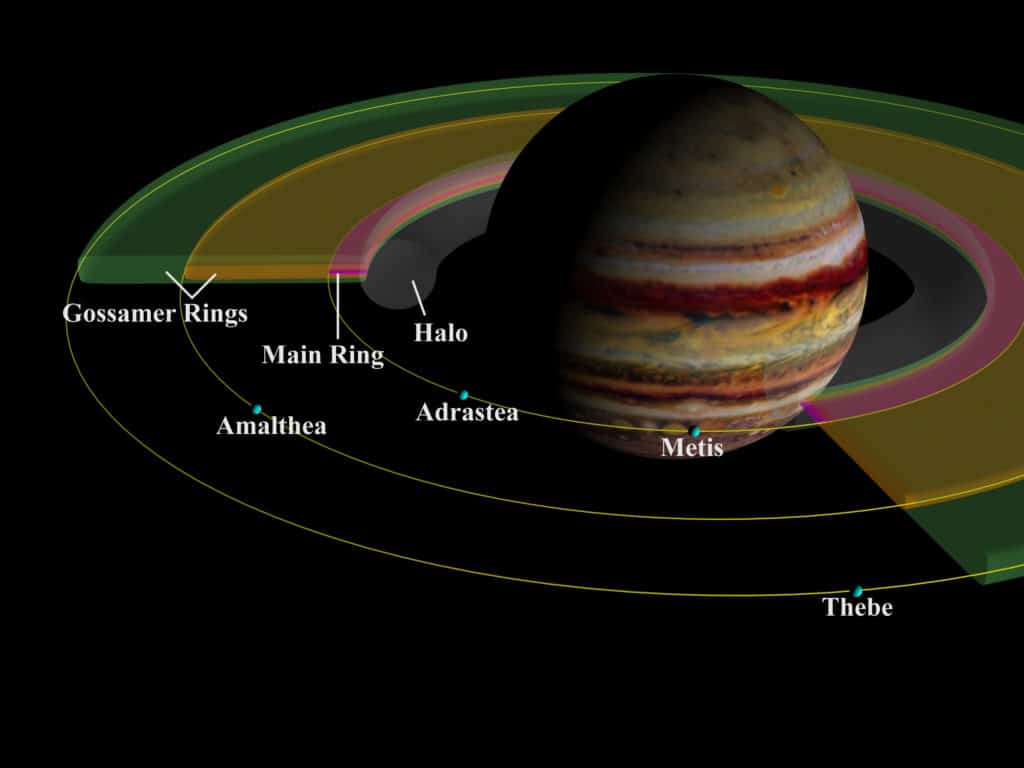
In a similar manor, the moons Thebe and Amalthea probably produce the two distinct components of the dusty gossamer ring.
Life Habitability
Since information technology doesn't have a true surface but rather swirling fluids it is not conducive to life as nosotros know information technology. Ganymede, Callisto, and Europa on the other hand, take higher chances of sustaining life.
Time to come plans for Jupiter
Juno is a spacecraft that was launched in 2022 and even now it is still analyzing Jupiter and sending information. Time to come missions are already fix in motion for Ganymede, Europa, Callisto and Io. They are set to be launched on 2022 and 2026. The high probability of life, the powerful volcanic activity and the overall missing details of Jupiter are strong factors in driving these missions.
Did you know?
- When Jupiter was formed it had twice its current diameter.
- Jupiter shrinks 2 cm every yr considering it radiates too much heath.
- Jupiter is and so massive that its barycenter with the Lord's day lies above the Sun's surface at 1.068 solar radii from the Sun's center. Information technology is the just planet whose barycenter with the Sun lies outside the volume of the Dominicus.
- If Jupiter would be 75 times more than massive, it would probably become a star.
- If a person who weighs 100 pounds on Globe would somehow stand on the surface of Jupiter, that person would weigh almost 240 pounds due to Jupiter'southward gravitational forcefulness.
- Although Simon Marius, a German astronomer, is not credited with the sole discovery of the Galilean satellites, his names for the moons were adopted.
- Jupiter experiences nigh 200 times more asteroid and comet impacts than Globe
- Jupiter has been called the Solar System's vacuum cleaner, because of its immense gravity well. Information technology receives the almost frequent comet impacts of the Solar System'southward planets.
- It was thought that the planet served to partially shield the inner arrangement from cometary battery. However, recent estimator simulations propose that Jupiter does non cause a cyberspace decrease in the number of comets that pass through the inner Solar System, every bit its gravity perturbs their orbits inward roughly equally often equally it accretes or ejects them. This topic remains controversial.
- Jupiter may accept been responsible for the Late Heavy Bombardment of the inner Solar System'southward history.
Sources:
- NASA
- Wikipedia
Image source:
- https://upload.wikimedia.org/wikipedia/commons/5/50/Jupiter%2C_image_taken_by_NASA%27s_Hubble_Space_Telescope%2C_June_2019_-_Edited.jpg
- https://upload.wikimedia.org/wikipedia/commons/c/cb/Jupiter-bonatti.png
- https://upload.wikimedia.org/wikipedia/eatables/0/02/SolarSystem_OrdersOfMagnitude_Sun-Jupiter-Earth-Moon.jpg
- https://www.inverse.com/article/56489-jupiter-at-opposition-2019
- https://upload.wikimedia.org/wikipedia/eatables/thumb/b/b5/Jupiter_diagram.svg/800px-Jupiter_diagram.svg.png
- https://upload.wikimedia.org/wikipedia/commons/8/84/PIA21973-AboveTheCloudsOfJupiter-JunoSpacecraft-20171216.jpg
- https://upload.wikimedia.org/wikipedia/commons/0/04/Hubble_Captures_Vivid_Auroras_in_Jupiter%27s_Atmosphere.jpg
- https://upload.wikimedia.org/wikipedia/commons/3/30/NASA14135-Jupiter-GreatRedSpot-Shrinks-20140515.jpg
- https://upload.wikimedia.org/wikipedia/commons/f/f2/Ganymede_g1_true-edit1.jpg
- https://upload.wikimedia.org/wikipedia/commons/7/7b/Io_highest_resolution_true_color.jpg
- https://upload.wikimedia.org/wikipedia/eatables/due east/e4/Europa-moon-with-margins.jpg
- https://upload.wikimedia.org/wikipedia/commons/eastward/e9/Callisto.jpg
- https://upload.wikimedia.org/wikipedia/commons/2/29/PIA01627_Ringe.jpg
Source: https://nineplanets.org/jupiter/
Posted by: rogersbethen.blogspot.com


0 Response to "how long is a day on jupiter"
Post a Comment